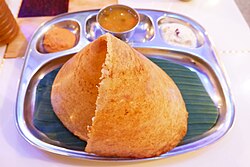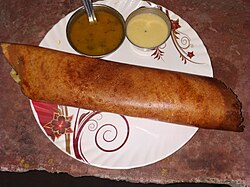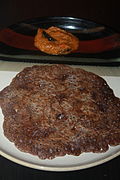| Name | Description |
|---|
| Uttapam | This variety of dosa is much thicker and softer and served with vegetable toppings. It also uses less oil, hence is considered healthier than the typical dosa. It takes more time to prepare than a regular dosa. Both surfaces may be baked. They are eaten like a regular dosa with servings of sambhar and chutney. Its history is as old as the dosa, featuring in Sangam literature. It is closely related to both the dosa and the appam. |
| Masala dosa | Roasted and crispy dosa, served with potato curry, chutney and sambar |
| Oats dosa | Healthy, crisp and lacy instant dosa made with oats |
| Wheat dosa | Dosa made with wheat flour batter; a typical wheat dosa may consume more oil and takes longer to prepare than a regular dosa. Instead of oil, ghee or butter may be used. |
| Set dosa | Smaller, spongy, soft and light, served in a set of 2-3 dosa per serving |
| Red rice dosa | A healthier variant of the regular dosa, it uses red rice instead of white rice, though the batter may also involve a mixture of the two rice varieties, too. |
| Plain dosa | Dosa has light texture and can be crispy. |
| Kal dosai | A thicker, softer, and spongier variant of a plain dosa, it also uses a stone tawa instead of the regular iron tawa for other dosas. |
| Tandoori dosa | A variety of dosa that uses a tandoor to prepare it instead of a tawa |
| Ghee roast | (Nei dosai in Tamil) Plain dosa cooked with ghee instead of oil and usually with no filling |
| Paper roast/Plain roast dosa | A large, plain dosa known for its thin layer and crispiness resulting from making a very thin layer of batter and the addition of extra oil compared to plain dosa |
| Egg dosa | (Muttai dosai in Tamil) A thicker base of dosa topped with beaten egg, or beaten egg is added to batter before cooking. |
| Kari dosai | A Tamil Nadu specialty with a dosa of thicker base topped with cooked meat, usually chicken or mutton: Dosas topped with vegetables or vegetable curry are also sometimes referred to as kari dosai. |
| Madurai kari dosai | A famous variant of kari dosai is the Madurai kari dosai. This has a vegetarian and a non-vegetarian variant. The latter consists of non-vegetarian toppings of a mix of omlette, minced meat, and without vegetables, while the former has a fully vegetarian topping of vegetable curry. |
| Pori dosa/Puffed rice dosa | Uses some puffed rice alongside raw rice and some lentils in the batter |
| Paneer dosa | Spiced, flavorful paneer filling inside the dosa |
| Palak dosa | Layered with palak (spinach) paste inside the folds of dosa |
| Pizza dosa | A fusion of the traditional dosa and a regular pizza, it comes in many subvariants. It primarily uses toppings that resemble those of a regular pizza. |
| Spring roll dosa | A fusion of the traditional plain dosa and the spring roll, it has vegetarian and non-vegetarian variants. It uses the same stuffing as in the spring roll and is usually cut and served rolled up as a spring roll. It is also notably spicy. |
| Jini dosa | A variety from Mumbai; a crispy, cheesy dosa stuffed with a spicy mix of vegetables such as cabbage, carrots, and capsicum in addition to a tangy sauce. |
| Schezwan dosa | A type of dosa with stuffing of a mix of cooked vegetables and Schezwan sauce |
| Mini soya dosa [21] | Soya milk and wheat flour [22] |
| Pesarattu (green dosa) [23] | Made with green gram. [24] It is served with Allam Pachadi. (Ginger chutney) |
| Adai dosa | From Tamil Nadu, it is a dosa-like dish prepared from a combination of toor dal, rice, curry leaves, red chillies, and asafoetida. The batter is not fermented, and is usually eaten with jaggery or aviyal . |
| Light white dosa | Rice and coconut [25] |
| Kadapa Neyyi karam dosa [26] | Rice flour fermented overnight and mixed with sodium carbonate. The topping is a mixture of onion and chili paste (called yerra karam) and a chutney made with tomato and flour made in a gravy of curd. It is roasted in Ghee. It is also occasionally topped with fried gram powder. [26] |
| Onion rava dosa [27] | Semolina, rice flour, onion |
| Ragi wheat dosa | Ragi, whole wheat flour [28] |
| Rava dosa | Made with rava or sooji (semolina), it is a healthier alternative to regular dosa. Rava dosa takes up more oil than a regular dosa and can stick to the tawa if enough oil is not used. It also takes more time to prepare than a regular dosa. |
| Benne dose | Made with butter (benne in Kannada), it is predominantly famous as Davanagere benne dose associated with the Davanagere district in Karnataka. |
| Neer dosa | Made with a watery rice batter |
| Vodu dose or Kappa roti | Vodu dose or kappa roti is made from unfermented rice, fenugreek, grated coconut, thinly flattened rice, and sometimes leftover cooked rice. It is cooked on an earthen pan with a rounded bottom. It is fluffy and appears like a bread. It is cooked without the use of oil. |
| Amboli, ghavan, dhirde | In coastal parts of Maharashtra, variations known as amboli and ghavan are thin rice crêpes prepared with fermented batter, while dhirde is prepared with unfermented batter. |
| Buttermilk dosa | Semolina, maida, buttermilk [29] |
| Jaggery dosa | Rice flour, maida, grated coconut, jaggery. |
| Minapattu | Very similar to plain dosa, this version tends to be thicker and, compared to plain dosa, it has a greater ratio of urad dal to rice flour or, in some cases, idli rava. |
| Maida dosa | The maida dosa batter is made from maida (refined flour) by adding water to get dense consistency; chopped onion, chilli, coriander leaves, and salt are added for taste. Maida dosa is quickly made in many households of Karnataka state, India. |





























